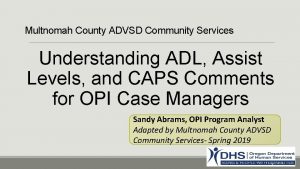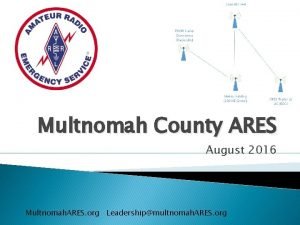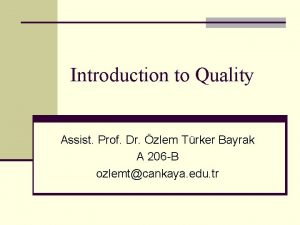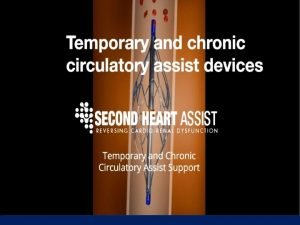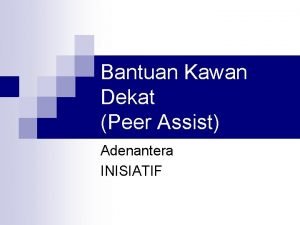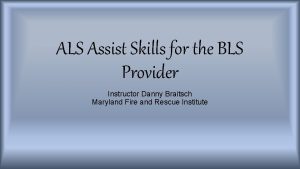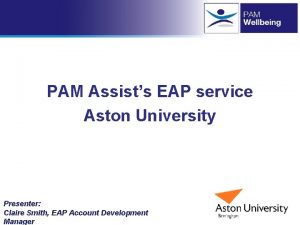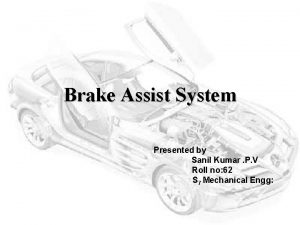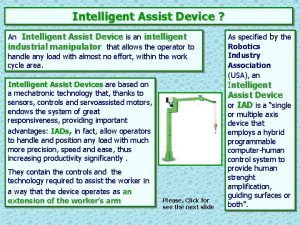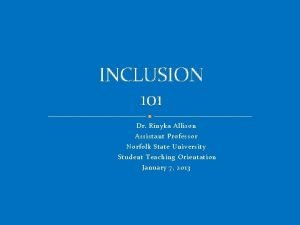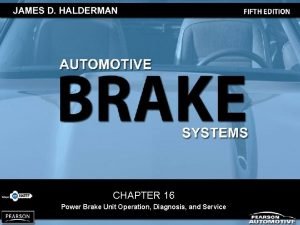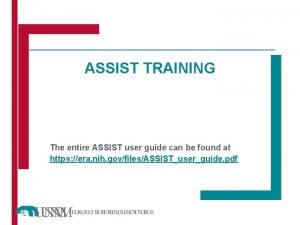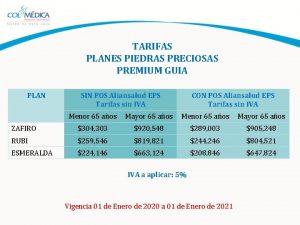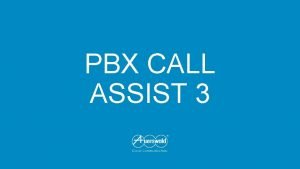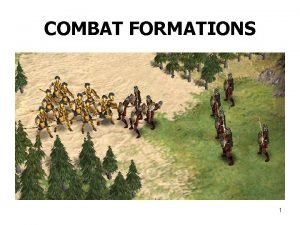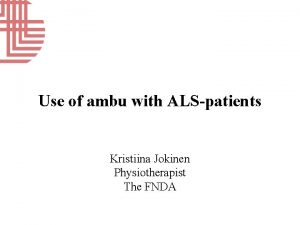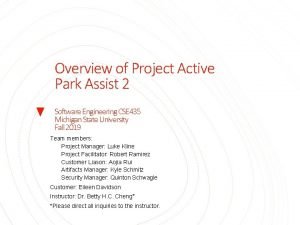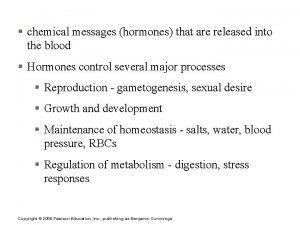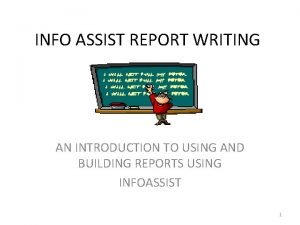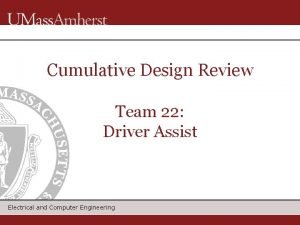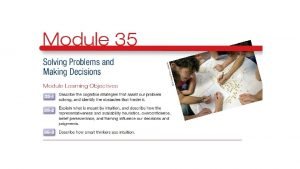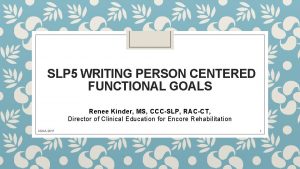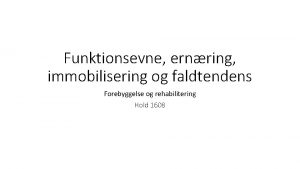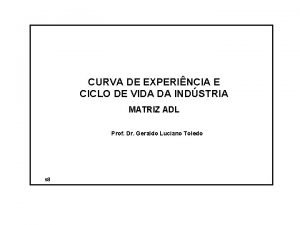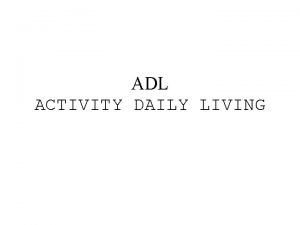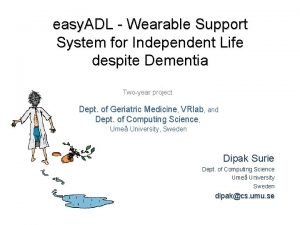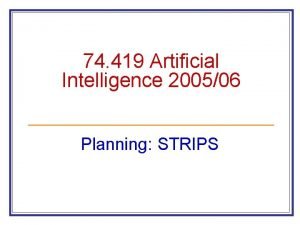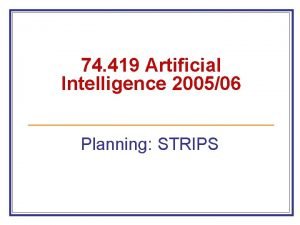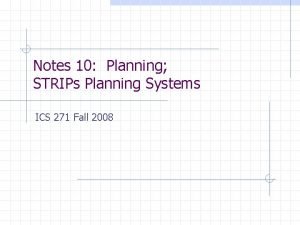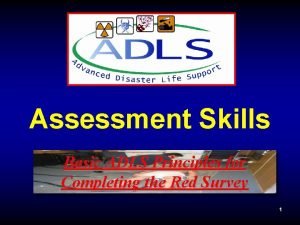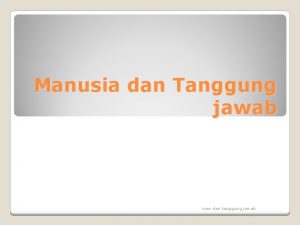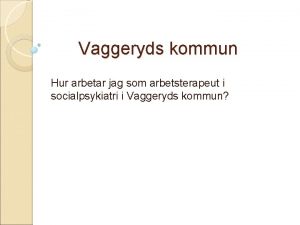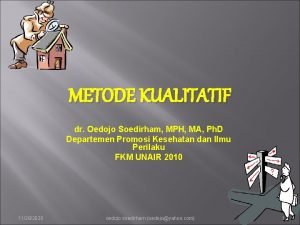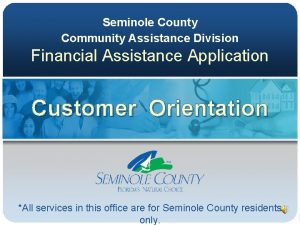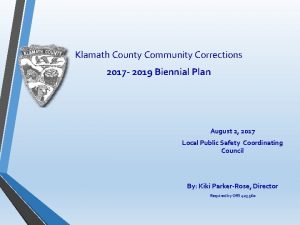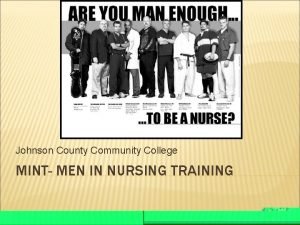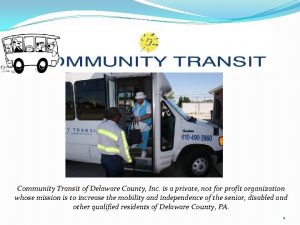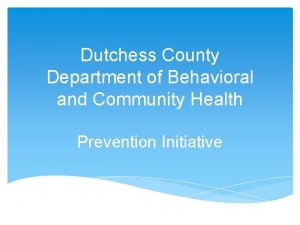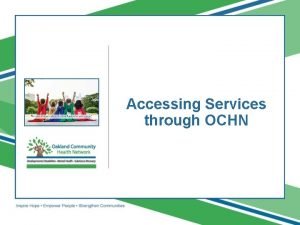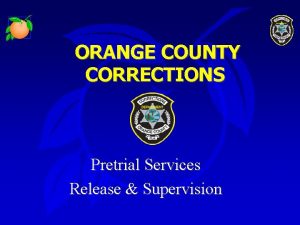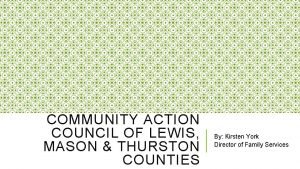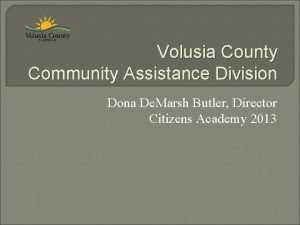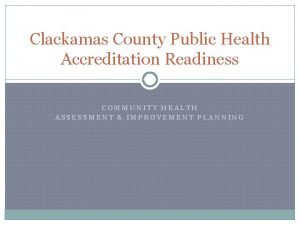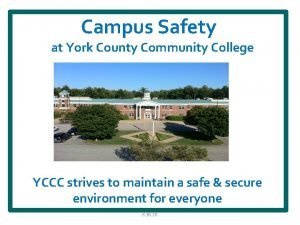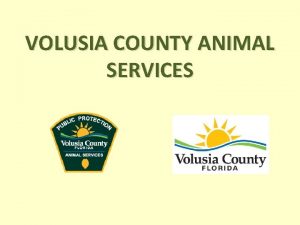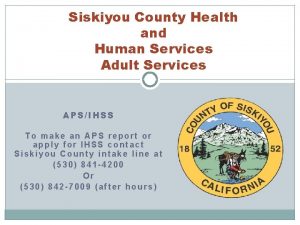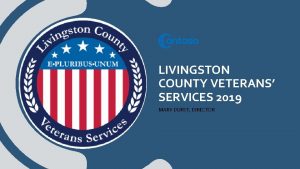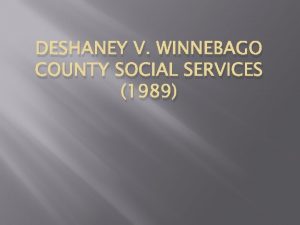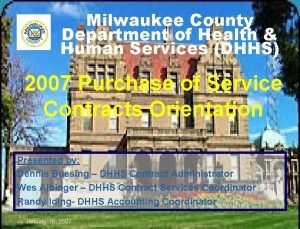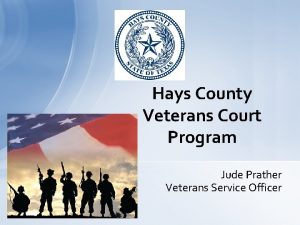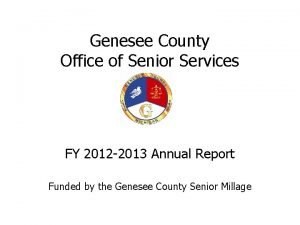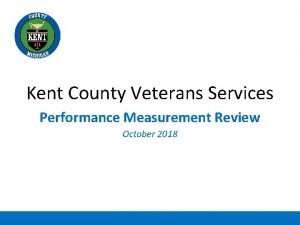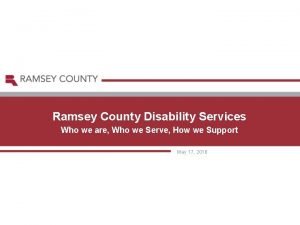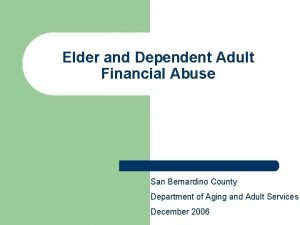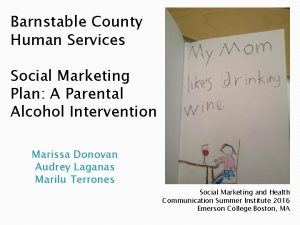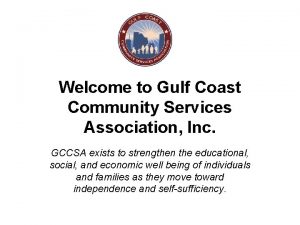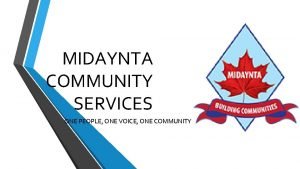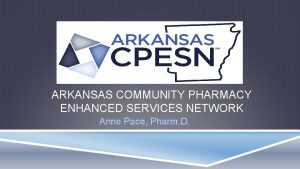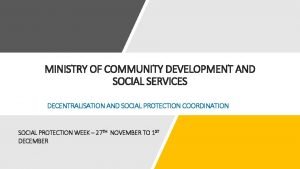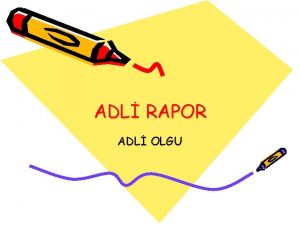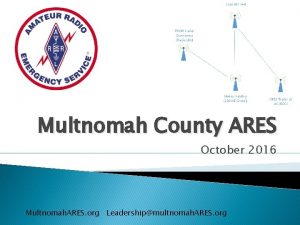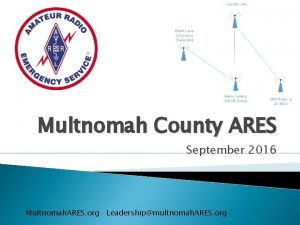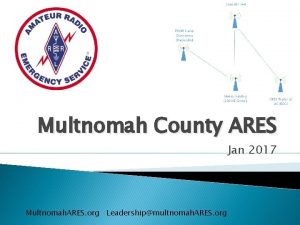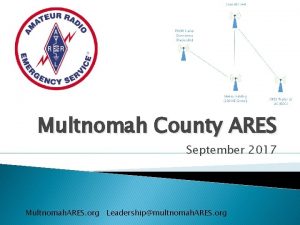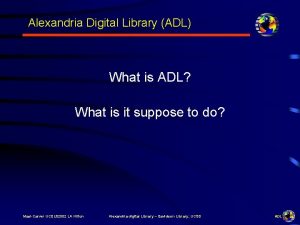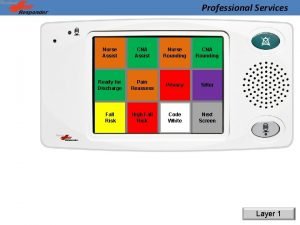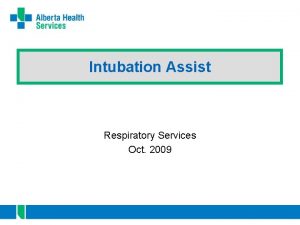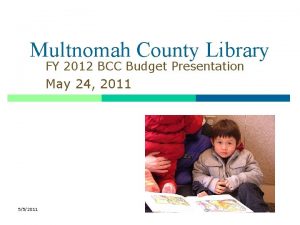Multnomah County ADVSD Community Services Understanding ADL Assist



































































































































- Slides: 131

Multnomah County ADVSD Community Services Understanding ADL, Assist Levels, and CAPS Comments for OPI Case Managers Sandy Abrams, OPI Program Analyst Adapted by Multnomah County ADVSD Community Services- Spring 2019 1

INTRODUCTIONS Your name Where you work How long you have been an OPI case manager 2

GUIDELINES & HOUSEKEEPING Please keep your phone on silent ◦ Step out of the room to use your phone No side conversations Bathrooms – location – as needed Stand, stretch, snack as needed Break: 2: 45 3

OBJECTIVES When you leave this class, you will be able to: Complete an accurate CAPS assessment Determine appropriate assist levels for each ADL and IADL Write strong, specific comments to support your decisions Use the Narration Template 4

PREP FOR SAFETY Research! Check narration and talk with others who are familiar with the case Google Maps Pack necessities only Tell someone where you are going and when you will be back. Dress for field work 6

SAFETY AS YOU ARRIVE: • Pass by the house. Check things out. • Position yourself to the side of the room nearest the door • Do NOT walk in front of the consumer or others in the home (follow them) • Do not take personal information with you • Set boundaries 7

SAFETY AS YOU LEAVE: • Avoid bringing home pests • Leave as soon as you are done • Drive to a safe place to take notes 8

BUILDING RAPPORT • Explain why you are there • Careful about oversharing • Find commonalities ◦ Examples? 9

THE ART OF ACTIVE LISTENING • Restating • Summarizing • Reflecting Feelings • Validation • Clarifying • Paraphrasing • • Redirecting Open-Ended Questions Probing Be OK with silence 10

TIPS TO ENHANCE COMMUNICATION Face the person and maintain eye contact Use other forms of communication if necessary Limit distractions Allow the person their own reality Use simple words and short sentences; ask one question at a time Speak naturally, with your face well lit Use concrete statements, “I will be there at two Get their attention; identify yourself and o’clock” call the person by name Ask one question at a time Avoid correcting the individual Ask before attempting to finish the person’s sentences Be patient Rephrase rather than repeat Be honest if you can’t understand Be prepared with interpreting services ◦ Direct questions directly to the consumer, not interpreter 11

Communicating with People who are Deaf or Hard of Hearing Speak slowly, loudly and naturally using no acronyms or jargon Speak clearly Reduce background noise whenever possible Avoid sudden topic changes and long sentences/stories Rephrase and repeat as needed Don’t hesitate to ask if they can hear you ok Give the individual time to process your question Supplement the conversation with written material Be prepared with interpreting services 12

Communicating with People who have Aphasia and/or Stroke Survivors Communicating via Phone Communicating Face-to-Face Speak slowly and clearly Speak slowly, loudly and clearly Give them time to process and time to talk Face to them and keep eye contact Keep it simple Rephrase and repeat Avoid correcting the individual Be patient Follow-up with written material Give them time to process and time to talk Use other forms of communication if necessary Be honest if you can’t understand Follow-up with written material 13

Communicating with People who have Alzheimer’s or Dementia Identify yourself and call the person by If the conversation stops making sense, do not correct the person name Be a good listener - Give them time to Try to find meaning in what is being said/done talk Limit distractions If needed, assist the person with orientation Speak slowly and distinctly Use simple words Repeat yourself if needed Use concrete statements, “I will be there at two o’clock” Ask one question at a time Don’t attempt to finish the person’s sentences…. If you need to, it’s fine…. but ask first 14

WHAT TO ASSESS Use the assessment time frame (30 days before and 30 days after visit), to assess an individual’s: ◦ ABILITY to perform ADL and IADL tasks in a safe and dignified manner ◦ ABILITY to address health and safety concerns ◦ PREFERENCES with consideration of meeting their health and safety needs OAR 411 -015 -0008(1)(a) 15

HOW TO ASSESS Conversation Observation Information Gathering 16

DOCUMENTING THE ASSESSMENT The 3 Core Questions to address in CAPS comments: 1. Why is there a need? 2. How frequent is the need? 3. How is the assistance being provided? 17

CAPS Comments First, Why they have the need should be clearly stated in the comments. Second, How frequently the consumer requires assistance. Be specific, not “occasionally” or “at times” Describe why the need is less frequent than each day or always. Third, Describe how and what the provider is doing to assist the individual, instead of stating the assist type.

When a reassessment is being conducted, staff must document in the comment section in each ADL and IADL, any changes that have occurred since the previous assessment. CAPS Comments in a reassessment This is a new requirement, resulting from the need for transparency in the assessment process. This Photo by Unknown Author is licensed under CC BYNC-ND

DOCUMENTING THE ASSESSMENT Address any changes from the previous assessment ◦What changed? ◦How did it change? ◦Why did it change? 20

CONFLICTING STATEMENTS Co r e b nsu em me r M y il m a F G e r a C r e iv Fri e nd 21

YOU MAKE THE CALL The final decision is what you determine is an accurate portrayal of the consumer’s needs 22

ACTIVITIES OF DAILY LIVING What is an ADL? “those personal functional activities required by an individual for continued well-being, which are essential for health and safety” OAR 411 -015 -0005 (2) 23

ACTIVITIES, COMPONENTS & TASKS Activities are comprised of Components are comprised of Tasks are the steps necessary to complete an Activity or Component 24

Task Component ADL Task Assist Type Task Component Assist Type Task ADL Assist Levels 25

ADL Mobility Eating Elimination Cognition Bathing/ Personal Hygiene Ambulation Eating Bladder Self-Preservation Bathing Dressing Bowel Decision- Making Personal Hygiene Grooming Toileting Ability to Make Self Understood Transfers Dressing/ Grooming Challenging Behaviors 26

ASSISTANCE TYPES Hands-on Cueing Reassurance Set-up Monitoring Redirection Stand-by Support OAR 411 -015 -0005(7)(a-h) 27

ASSIST LEVELS • • Minimal Assist Substantial Assist Full Assist 28

Comments in CAPS - Independent When a consumer is assessed as Independent in any ADL or IADL, you must include an explanation of how or why the consumer is independent in the comment section. “Independent” should never be the only word in the comments section. The comments section should never be left blank for any ADL. 29

Comments in CAPS - Independent • Important to explain what happened if assist level has changed to independent since previous assessment • Describe devices and tools used by the consumer • If independent status has not changed, a simple comment is enough • Comment should reflect your reasoning 30

Comments Examples - Independent Case manager witnessed consumer using walker to ambulate independently. Consumer states that she performs all bathing tasks unassisted. The consumer does not have any catheter or ostomy care needs. Consumer continues to be independent and doesn’t report problems with toileting. 31

MOBILITY OAR 411 -015 -0006 (7) 32

Inside Ambulation MOBILITY Outside Up/Off Transfers Down/On Repositioning 33

AMBULATION ASSIST LEVELS Minimal Assist Needs hands-on assistance of another person outside the home or care setting at least one time a week totaling four days a month or Needs hands-on assistance inside home or care setting less than one time each week 34

AMBULATION ASSIST LEVELS Substantial Assist Needs hands-on assistance inside home or care setting and Help is needed periodically at least one day each week totaling four days per month Full Assist Needs hands-on assistance to ambulate every time the activity is attempted or Is restricted to bed 35

TRANSFER ASSIST LEVELS Assist Even with assistive devices, the individual needs hands-on assistance with a task of transferring inside their home or care setting and Help is needed at least one time a week totaling four days a month Full Assist The individual always needs hands-on assistance throughout all tasks, every time the activity is attempted, even with assistive devices 36

Inside Ambulation MOBILITY Outside Hands-on Up/Off Transfers Down/On Hands-on Repositioning 37

MOBILITY ASSIST LEVELS Minimal Assist • Needs Minimal Assistance in Ambulation Substantial Assist • Needs Substantial Assist with Ambulation or • Needs Assist with Transfer Full Assist • Needs Full Assist with Ambulation or • Needs Full Assist with Transfer 38

Minimal Assist = 1 x week outside, <1 x week inside Substantial Assist = 1 x week inside Full Assist = every time Ambulation MOBILITY Outside Hands-on Up/Off Transfers Assist = 1 x week, 4 x month Full Assist = every time Inside Down/On Hands-on Repositioning MOBILITY Minimal Assist = Min Assist in Ambulation Substantial Assist = Sub Assist in Ambulation or Assist with Transfer Full Assist = Full Assist in Ambulation or Transfer 39

MOBILITY CONSIDERATIONS • Hands-on assist only • Assess with assistive devices • Location – • Ambulation: inside and outside the home • Transfers: inside the home ◦ Falls: NOT: ◦ What if they fall? ◦ NOT: ◦ Exercise, ROM or PT ◦ In/out of shower ◦ In/out of vehicle 40

AMBULATION COMMENT Shirley and her husband state that she gets extremely tired and weak causing her to be unsteady on her feet following her dialysis treatments, which she receives three days a week. By the end of the day following each treatment, even with the use of her walker, he must walk beside her and steady her using a gait belt when moving around in the house. Shirley reports she attempted to walk to the kitchen on her own three weeks ago, when she fell and was taken to the hospital with a broken wrist. She has not attempted to walk unassisted following a treatment since then. Shirley does not want to use a wheelchair, fearful that she will become dependent on it. What assist level would you choose? 41

TRANSFER COMMENT Lois is a person with Parkinson’s Disease, is non weight-bearing and is not able to participate in any part of the transfer process. Her family is unable to lift her and must use a Hoyer lift each time to get her safely from her bed to her wheelchair and vice versa. This task is required at least six times per day and takes approximately 15 minutes each time, which includes transferring to/from the toileting area when having a bowel movement. What assist level would you choose? ? 42

EATING 43

EATING ASSIST LEVELS Minimal Assist (B) Needs another person within sight and immediately available to actively provide hands-on assistance with feeding, attaching special utensils or immediate, hands-on assistance to address choking or Set-up assistance for nutritional IV or feeding tube or Cueing during the act of eating and Help is needed at least one time a week totaling four days a month 44

EATING ASSIST LEVELS Substantial Assist (C) Always needs one-on-one assistance for: ◦ Set-up of nutritional IV or feeding tube or ◦ Cueing during the act of Eating Full Assist (D) Needs help every time the activity of Eating occurs to provide: ◦ Direct feeding or ◦ Constant cueing to prevent choking or aspiration 45

Eating Hands-on Feeding Set-up Minimal Assist = hands-on with feeding, attaching special utensils, or immediate, hands-on assistance to address choking; or set-up of nutritional IV or feeding tube at least one x week / four x month Substantial Assist = always needs set-up of nutritional IV or feeding tube, or cueing during the act of Eating Full Assist = always needs help with direct feeding or constant cueing to prevent choking or aspiration Nutritional IV Set-up Cueing Feeding Tube Set-up 46

EATING COMMENT Sally likes to manage as much of her meal as she can on her own; however, typically she does not have the strength or dexterity to finish the meal on her own. Her spouse will physically feed Sally when this occurs. This happens at every meal – three times daily. Sally also has tremors which limit the amount and type of food she is able to put in her mouth on her own. What assist level would you choose? ? 47

Elimination: Bladder Bowel Toileting

Bladder Needs assistance from another person to accomplish the individual’s specific tasks of bladder care, with or without assistive devices, including tasks such as: ◦Catheter care; or ◦Ostomy care. 49

BLADDER ASSIST LEVELS Assist • Needs hands-on assistance with a task of Bladder care and • Help is needed at least one day each week totaling four days a month Full Assist • Always needs hands-on assistance to complete all tasks of Bladder care every time the task is attempted 50

BLADDER COMMENT Doug has a catheter. He does not understand the reason for the catheter and sometimes tries to remove it. He is unable to empty the bag or clean the catheter on his own or do any catheter care. His wife does all tasks related to the catheter for him. Doug said he goes to the Doctor once a month for it to be replaced. What assist level would you choose? 51

Bowel Needs assistance from another person to accomplish the individual’s specific tasks of bowel care, with or without assistive devices, including tasks such as: ◦Digital stimulation; ◦Suppository insertion; ◦Ostomy care; or ◦Enemas. 52

BOWEL ASSIST LEVELS Assist • Needs hands-on help with a task of Bowel care and • Help is needed at least one day each week totaling four days a month 53

BOWEL ASSIST LEVELS Full Assist • Always needs hands-on assistance to complete all tasks of Bowel care every time and • No bowel movement occurs without a task being completed 54

BOWEL COMMENT Due to the Charlie’s history of bowel blockage, which typically occurs 1 -2 times a week, an enema is required. His wife or caregiver must complete the enema due to Charlie’s pain and limited range of motion. Prior to receiving these weekly enemas, Charlie has suffered severe pain due to the blockage, has been hospitalized, and has required surgery to unblock his intestines. What assist level would you choose? 55

Toileting Needs CUEING to prevent incontinence or HANDS-ON assistance to • cleanse after elimination, • change soiled incontinence supplies or soiled clothing, or • to remove and replace clothing to enable elimination. 56

TOILETING ASSIST LEVELS Assist • Needs hands-on assistance with a task of Toileting or • Cueing to prevent incontinence and • Assistance is needed at least one day each week totaling four times a month 57

TOILETING ASSIST LEVELS Full Assist • Always requires hands-on assistance through all tasks, every time the consumer eliminates to: ◦ Cleanse after elimination and ◦ Change soiled incontinent supplies or soiled clothing and ◦ Adjust clothing to enable elimination or • Always requires cueing from another person during the entire act of elimination to prevent incontinence 58

TOILETING COMMENT Bob has muscle weakness throughout his body due to myofibril myopathy. Due to this weakness, his HCW must cleanse Bob after elimination and adjust his clothing each time. This task takes approximately 30 minutes each time, six times a day. In addition, when Bob has accidents, he is unable to change or manage his incontinence supplies without his HCW’s assistance. What assist level would you choose? 59

ELIMINATION ASSIST LEVELS Assist • Requires assistance in at least one of the three components inside the home or care setting Full Assist • Requires full assistance in any of the three components inside the home or care setting 60

ELIMINATION Hands-on Bladder Bowel Hands-on Toileting Cueing Catheter Care Enemas Adjusting clothing to enable Elimination Ostomy Care Suppository Insertion Changing soiled incontinence supplies or clothing Ostomy Care Cleansing after Elimination Digital Stimulation Cueing to prevent incontinence Assist = Assist in one of the three components Full Assist = Full Assist in any one of the three components 61

COGNITION 62

COGNITION Cognition refers to how the brain functions and uses information ◦Cognition is about the inability of the person to use information appropriately ◦NOT about poor choices or personality 63

Time frame for assessing cognition Time frame may be expanded when assessing cognition and behaviors “without supports” when: ◦The person has a history or incidents more than 30 days in the past; and ◦The history or incident jeopardized the health and safety; and ◦The individual still has a current concern that needs to be addressed. 65

Consider how the person would function or has functioned without supports, meaning assistance of another person, care setting or alternative service resource. ◦What has the provider started doing that has changed this behavior or cognitive problem? ◦Does the person have something, such as a behavior plan, that is mitigating the problems? ◦Does the current situation prevent the person from having symptoms? 66

Assessing Cognition Some individuals ‘talk a good Should be natural in talk’, so having historical conversation, not information of their cognition is interrogation-like critical Paint the picture, and use that If the consumer has no cognitive information to conclude needs, you should still document cognitive functioning Consumers with NO cognitive how this was determined to demonstrate these areas have deficits should be able to been assessed sequence specific events 67

Assessing Cognition: Information Gathering Prior to the assessment, information may have been provided. For example, previous assessments, screening information, care plans, narration, and reports from those involved in the individual’s care, etc. , may all be considered if the information is relevant to the individual’s current needs. Information that is gathered may or may not be indicative of cognitive needs. 68

Assessing Cognition: Information Gathering The family is reporting that the consumer is leaving the stove on The consumer puts themselves in danger (without regard to safety) The consumer is unaware of concerns regarding abuse, neglect, or exploitation The consumer is getting lost in their home or in the community Others in the community are routinely checking in on the individual The consumer has a history of failed placements or evictions 69

Assessing Cognition: Observations When meeting with the individual, sometimes you may observe things that raise some red flags. ◦ The consumer is rapidly losing weight ◦ Clothing is soiled ◦ Personal hygiene is not being managed ◦ Stack of bills are on the table ◦ Safety concerns in the home 70

Assessing Cognition: Conversation The conversation, as much as possible, should be based upon observations and any information gathering that has occurred. ◦ Examples: You have learned that the individual is no longer shopping for their food. Discuss how they are meeting their shopping needs. Or: You have observed a stack of bills on the table. Discuss how they are managing their bills. However, in some assessments, observation and any information gathered may not be enough. The following techniques may be considered to help determine if an individual has cognitive needs: 72

Assessing Cognition: Conversation Routine: Sequencing: ◦ Conversations should generally ◦ Conversations should include focus on daily, weekly, and monthly step by step details on how a routines. Individuals without specific task is completed. cognitive issues should be able Individuals without cognitive answer these types of questions issues should be able to easily. Consider having these sequence their tasks with discussions prior to even starting ease. into the first ADL question. 73

Assessing Cognition: Conversation Routine examples: ◦ “What do you do during a typical day? ” ◦ “Are there specific things you do on a weekly or monthly basis? ” ◦ “I see that you enjoy going to church/club/group. That sounds interesting, can you describe what that is like? “ ◦ “Paying bills is certainly not fun! If you don’t mind sharing, can you describe how you manage them? ” ◦ “Does somebody come by and help you with any of your routines? ” ◦ “What does your morning/evening routine look like? ” 75

Assessing Cognition: Conversation Sequencing examples: ◦ “I’m interested in knowing about when you need to go to the grocery store. How do you usually prepare for it? ” ◦ “I enjoy making spaghetti! Do you make it as well? How do you make it? ” ◦ “It can be tricky when there are quite a few medications to manage. How do you currently manage your medications? ◦ “Can you tell me of any important decisions you had to make recently? What did that involve? ” ◦ “I understand that you may need help with X. What are your preferences in having these needs met? ” ◦ “What kind of bills do you pay, and how do you have them organized? ” 76

Ability to Make Self Understood Decision-Making COGNITION The individual’s mental functional ability to ensure their health, safety and basic needs are met. Self-Preservation Challenging Behaviors 77

SELF-PRESERVATION An individual’s actions or behaviors reflect an understanding of their health and safety needs and how to meet those needs 78

SELF-PRESERVATION ASSIST TYPES Hands-on Cueing Reassurance Monitoring* Redirection Support* * Assist types of Monitoring and Support are not included for a Full Assist 79

SELF-PRESERVATION Minimal Assist Needs assistance because they are unable to understand the need for self-preservation and Assistance is needed at least once a month or is eventspecific Substantial Assist Needs assistance because they are unable to understand the need for self-preservation and Assistance is needed daily 80

SELF-PRESERVATION Full Assist Needs assistance because they are unable to understand the need for self-preservation and Needs constant assistance to the point they cannot be left alone without risk of harm to themselves or others or they would experience significant negative health outcomes 81

SELF-PRESERVATION COMMENT John has advanced dementia and is living with family. He requires support all day, every day because of the level of dementia. He no longer understands basic lifesustaining activities such as eating, drinking, bathing and elimination. The caregiver must provide hands-on assistance and cueing during activities and tasks throughout the day. Due to the level of care required to ensure his health and safety throughout the day, John cannot be left alone for even short periods of time during the day. John worked as a chef his whole life and continually goes into the kitchen, turning on the stove and oven and attempting to use the knives. The caregiver must constantly redirect him with activities away from the kitchen and remind him that he is now retired. What assist level would you choose? ? 82

DECISION-MAKING An individual’s ability to make everyday decisions about ADL, IADL and the related tasks. An individual needs assistance if they: • demonstrate they are unable to make decisions, • need help understanding how to accomplish the tasks necessary, or • do not understand the risks or consequence of their decisions 83

DECISION-MAKING ASSIST TYPES Hands-on Cueing Redirection Monitoring* Support* *Assist types of Monitoring and Support are not included for a Full Assist 84

DECISION-MAKING Minimal Assist Needs assistance to make necessary decisions to stay safe and healthy and Assistance is needed at least once a month or is event-specific Substantial Assist Needs assistance with cueing, hands-on, monitoring, redirection or support to make necessary decisions to stay safe and healthy and Assistance is needed daily 85

Full Assist DECISION-MAKING Needs assistance to make necessary decisions to stay safe and healthy and Needs constant assistance to the point they cannot be left alone without risk of harm to themselves or others or they would experience significant negative health outcomes 86

DECISION-MAKING COMMENT Darren requires daily monitoring and redirection from his caregiver due to complications from a TBI to ensure that he is completing his daily routines. In order to do this, the caregiver comes to Darren’s home at lunch time each day to ensure that he has eaten appropriately, taken his medication, dressed appropriately, and has completed any other necessary daily tasks. Additional tasks include creating a grocery list, paying his bills, and taking a shower. When any of the tasks have not been completed, Darren’s HCW must cue him throughout the task in order to complete it. Previously, when Darren did not receive this level of care, he was hospitalized due to malnutrition and infection from not cleansing an open wound. What assist level would you choose? 87

ABILTY TO MAKE SELF UNDERSTOOD An individual’s cognitive ability to communicate or express needs, opinions or urgent problems, whether in speech, writing, sign language, body language, symbols, pictures, or a combination of these. An individual needs assistance in this area if they demonstrate an inability to express themselves clearly to the point their needs cannot be met independently. 88

MAKE SELF UNDERSTOOD ASSIST TYPES Hands-on Cueing Reassurance Monitoring* Redirection Support* *Assist types of Monitoring and Support are not included for a Full Assist Hands-on Assist type is included for a Full Assist only 89

ABILTY TO MAKE SELF UNDERSTOOD Minimal Assist Needs assistance to find the right words or in finishing their thoughts to ensure their health and safety and Assistance is needed at least once a month or is event-specific Substantial Assist Needs assistance to communicate their health and safety needs and Assistance is needed daily 90

ABILTY TO MAKE SELF UNDERSTOOD Full Assist • Needs assistance to communicate their health and safety needs and • Needs constant assistance to the point they cannot be left alone without risk of harm to themselves or others or they would experience significant negative health outcomes 91

MAKING SELF UNDERSTOOD COMMENT Alice has been diagnosed with Alzheimer's. She is unable to tell her caregiver when she is hungry or when she needs her pain medications. During a home visit, the CM observed Alice struggling to find the words to explain to her caregiver that she was thirsty. The caregiver must try to interpret what the Alice needs or cue her with appropriate words or expressions. Alice needs this assistance every day. What assist level would you choose? 92

CHALLENGING BEHAVIORS An individual exhibits behaviors that negatively impact their own or others’ health or safety and the individual does not understand the impact or outcome of their decisions or actions. 93

CHALLENGING BEHAVIORS ASSIST TYPES Hands-on Cueing Reassurance Monitoring* Redirection Support* *Assist types of Monitoring and Support are not included for a Full Assist Reassurance Assist type is included for a Minimal Assist only 94

CHALLENGING BEHAVIORS Minimal Assist Needs assistance with cueing, hands-on or redirection to deal with a behavior that may negatively impact their own or others’ health or safety and Assistance is needed at least once a month Substantial Assist Needs assistance with cueing, hands-on, monitoring, or redirection and Assistance is needed daily 95

CHALLENGING BEHAVIORS Full Assist Needs assistance with cueing, hands-on, reassurance or redirection to manage or mitigate behaviors to prevent significant harm to themselves or others and Needs constant assistance to the point they cannot be left alone without risk of harm to themselves or others or they would experience significant negative health outcomes 96

CHALLENGING BEHAVIORS COMMENT Mr. Garcia has a significant TBI and is no longer able to manage his behaviors, nor does he understand the impact of his decisions. Every day he must have one-to-one support to prevent unprovoked physical lashing out at other people. The caregiver provides redirection, reassurance and hands-on support. Mr. Garcia can never be left alone because of the significant danger to others. What assist level would you choose? 97

TIPS FOR INTERACTING WITH THOSE WHO HAVE CHALLENGING BEHAVIORS Set boundaries/ground rules Try to determine what is causing the difficult behavior Express empathy; Summarize and validate their concerns and needs Don’t take it personally; be objective and don’t get emotional Don’t allow yourself to be drawn into an argument Listen to the rant (within reason), there is a purpose and you can draw useful information from it 98

COGNITION ASSIST LEVELS Assist • Substantial Assistance in one of the four components or • Minimal Assistance in at least two of the four components Full Assist • Full Assistance in at least one of the four components or • Substantial Assistance in at least two of the four components 99

COGNITION Decision-Making Self-Preservation Cueing Hands-on Monitoring Reassurance Redirection Support Hands-on Cueing Redirection Monitoring Support Challenging Behaviors Making Self-Understood Cueing Hands-on Monitoring Redirection Support Cueing Hands-on Reassurance Monitoring Redirection Assist = Assist in one component or Min Assist in two Full Assist = Full Assist in one component or Sub Assist in two 100

DOCUMENTING THE ASSESSMENT The 3 questions to answer in CAPS comments: 1. Why is there a need? 2. How frequent is the need? 3. How is the assistance being provided 101

BATHING AND PERSONAL HYGIENE 102

In/Out of Shower Bathing BATHING & PERSONAL HYGIENE Personal Hygiene Washing Body Washing Hair Mouth Care Shaving Menstruation Care 103

BATHING ASSIST LEVELS Assist • The individual needs: ◦ Hands-on help for a task of Bathing or ◦ Cueing during the activity or ◦ Stand-by during the activity • Help is needed at least one day each week totaling four days a month 104

BATHING ASSIST LEVELS Full Assist The individual is unable to accomplish any task of Bathing without assistance ◦ Always requires hands-on assistance through all tasks of Bathing every time the activity is attempted 105

BATHING COMMENT George takes showers twice a week. He is unable to get in and out of the shower on his own due to muscle weakness in his legs. His HCW steadies him while he climbs into the showers and sits on his shower chair. Once he is in the shower, he is unable to bend over to wash his legs or lift his arms over his head to wash his hair due to poor range of motion. His HCW washes his hair and his body every time. What assist level would you choose? 106

BATHING & PERSONAL HYGIENE ASSIST LEVELS Assist • Requires Assist in Bathing or Full Assist in Personal Hygiene Full Assist • Requires Full Assist in Bathing 107

PERSONAL HYGIENE COMMENT Sam likes to be shaved daily. Due to tremors in his hands, he is unable to shave himself. He also cannot adequately clean his dentures, as he cannot see well enough to be sure they are clean. His HCW does all denture care and shaves Sam daily. What assist level would you choose? 108

In/Out of Shower Bathing BATHING & PERSONAL HYGIENE Washing Body Washing Hair Mouth Care Personal Hygiene Shaving Cueing Hands-on Stand-by Menstruation Care Minimal Assist = Assist in Bathing or Full Assist in Personal Hygiene Full Assist = Full Assist in Bathing 109

DRESSING & GROOMING 110

Putting Clothes on Dressing Taking Clothes off Shoes/Socks on/off DRESSING & GROOMING Hair Care Grooming Nail Care 111

DRESSING ASSIST LEVELS Assist • The individual needs: ◦ Hands-on help for a task of Dressing or ◦ Cueing during the activity or ◦ Stand-by during the activity • Help is needed at least one day each week totaling four days a month 112

DRESSING ASSIST LEVELS Full Assist The individual is unable to accomplish any task of Dressing without assistance ◦ Always requires hands-on assistance through all tasks of Dressing every time the activity is attempted 113

DRESSING COMMENT Mildred is unable to bend down to put on her shoes, socks and TED hose due to severe back pain, swelling of the feet and tightness of the TED hose. Facility staff does this for her each morning. Mildred states she usually wears a loose dress and is able to take that on and off on her own each day. What assist level would you choose? 114

GROOMING ASSIST LEVELS Assist • Needs hands-on, cueing or stand-by assistance with a task of Grooming • Assistance is needed at least one day each week / four days a month Full Assist • Always needs hands-on assistance to complete all tasks of Grooming every time the tasks are attempted 115

GROOMING COMMENT Due to severe contracture of his hands, Teddy is not able to hold clippers or a comb to complete his hair care or nail care. His HCW will comb his hair daily and clip his nails as needed, usually once a week. What assist level would you choose? 116

Putting Clothes on Dressing Taking Clothes off Shoes/Socks on/off DRESSING & GROOMING Hair Care Grooming Hands-on Cueing Stand-by Hands-on Cueing Nail Care Stand-by 117

DRESSING & GROOMING ASSIST LEVELS Assist • Requires assistance in Dressing or full assistance in Grooming Full Assist • Requires full assistance in Dressing 118

INSTRUMENTAL ACTIVITIES OF DAILY LIVING IADLs consist of: LAUNDRY HOUSEKEEPING MEDICATION MANAGEMENT MEAL PREPARATION SHOPPING TRANSPORTATION 119

HOUSEKEEPING The ability to maintain the interior of the residence for health and safety Wiping Surfaces Cleaning Floors Washing Dishes Taking Out Garbage Making the Bed Dusting Assist = Unable to accomplish some tasks without assistance Full Assist = Needs help with all tasks, every time they are attempted NOT Pet Care NOT Home Repair 120

LAUNDRY Gathering Soiled Clothing/Linens Using Washing Machine and Dryer Washing Soiled Clothing/Linens Hanging, Folding and Putting Away Clean Clothing/Linens Assist = Unable to accomplish some tasks without assistance Full Assist = Needs help with all tasks, every time they are attempted 121

MEAL PREPARATION The ability to safely prepare food to meet basic nutritional requirements Cutting Food Cooking the Meal Preparing Ingredients Placing Food within Reach Dinner is the main meal of the day, regardless of when the meal is served Meal Prep is assessed separately for each meal Minimal Assist = Able to accomplish most of the tasks without assistance Substantial Assist = Able to accomplish only a small portion of the tasks Full Assist = Needs help with all tasks, every time the tasks are attempted 122

MEDICATION MANAGEMENT Order Prescribed Medications Set-up Reminding Organize Prescribed Medications Checking for Effect Administer Prescribed Medications: Cueing O 2 Management Monitoring for Choking Minimal Assist = Able to accomplish most of the tasks without assistance Substantial Assist = Able to accomplish only a small portion of the tasks Full Assist = Needs help with all tasks, every time the tasks are attempted 123

SHOPPING Purchase goods that are necessary for health & safety Cleaning Supplies (Housekeeping) Medication (Med Management) Purchase goods that are related to the Service Plan Food (Meal Preparation) Toilet Paper (Elimination) Clothing (Dressing) Minimal Assist = Able to accomplish most of the tasks without assistance Substantial Assist = Able to accomplish only a small portion of the tasks Full Assist = Needs help with all tasks, every time the tasks are attempted 124

TRANSPORTATION Getting In or Out of a Vehicle Arranging Rides Assistance During a Ride For a Physical or Cognitive Need Minimal Assist = Able to accomplish most of the tasks without assistance Substantial Assist = Able to accomplish only a small portion of the tasks Full Assist = Needs help with all tasks, every time the tasks are attempted 125

The Synopsis – what to include • Issues that may affect the client’s living situation or be of concern during a case managers home visit • Client’s values, interests, history that may help case manager connect with or better understand client • An open field for the rest of the story not told elsewhere in the CAPS – easier to find than if buried in the narrative! 126

The Synopsis • Use of the Synopsis is optional • There is not a “wrong” way to use the Synopsis • Avoid duplicating info required elsewhere • Great place to leave details for the next case manager so they have a deeper understanding of the client 127

The Narration Template • Use for initial assessment • Use for re-assessment 128

The Narration Template We are asking OPI case managers to use the template for the following reasons: Captures all the needed narration Makes Quality assurance easier Makes sure all forms are completed and resources offered if appropriate 129

OPI Narration template for intakes and reviews OPI-CM: Date of home visit: Purpose of visit: Who was present: Consumer’s appearance: (appearance, i. e. , appropriately dressed for weather, bathed, groomed), mental state, i. e. , confused, alert, oriented) Why does the individual need or continue to need services? : 130

OPI Narration template for intakes and reviews Appearance/condition of the home: Living situation: rent, own, shared Number in household: Family/natural supports/social-emotional, who is helping the consumer now? CAPS complete and client continues to be SPL ___ see CAPS for details Finances: if the consumer does not manage them, who does? Net income: $X - $X max monthly co-pay and X % of cost 131

OPI plan effective date: 00/00/00 Consumer has chosen a HCW &/or IHCA: name and provider # (if needed) OPI Service Checklist: Does client receive or need Store to Door (shopping services), Adaptive equipment, extreme cleaning (prevention of eviction, health and safety, bed bug infestation), Adult Day Services? Referrals: Nutrition services (congregate or home delivered meals), emergency response system, home repair, library delivery services, etc. 132

Required Forms : Please indicate Y-- N/A 0287 L OPI Service Agreement in file? 0287 K Fee Determination Form updated in file? 354 Workers Comp Agreement in file (if using HCW)? Representative Choice Form 0737 on file? 3010 Authorization for Disclosure, Sharing and Use of Individual Information (Replaces the 2099 effective April 1, 2019) 2090 Privacy Rights (given to client)? 133

Required Forms: § § § 598 Task List mailed to consumer? 598 Task List mailed to HCW or agency? 4105 HCW Notice of Hours mailed to HCW (if using HCW)? 546 In Home Service Plan in file? 546 for New CAPS given to clerk &/or sent to agency (if using)? 134

HELPFUL WEBSITES Long-Term Care Service Priorities for Individuals Served http: //www. dhs. state. or. us/policy/spd/rules/411_015. pdf APD Case Management Tools http: //www. dhs. state. or. us/spd/tools/cm/ APD Staff Tools http: //www. dhs. state. or. us/spd/tools/index. htm ADVSD Provider Page: Case Management https: //multco. us/ads/cs-case-management 135
 Advsd
Advsd Multnomah county library
Multnomah county library Multnomah county ares
Multnomah county ares Wake county human services community services center
Wake county human services community services center Center for discovery sullivan county
Center for discovery sullivan county Cr assist
Cr assist Mcdp-1 defines trust as a product of
Mcdp-1 defines trust as a product of Quality assist
Quality assist Leslie miller md
Leslie miller md Cisco smart assist
Cisco smart assist Peer assist
Peer assist Als assist
Als assist The whips assist the party leaders by
The whips assist the party leaders by Travel guard modify policy
Travel guard modify policy What does pam assist stand for
What does pam assist stand for Mechanical brake assist
Mechanical brake assist Intelligent assist device
Intelligent assist device One teach, one assist pros and cons
One teach, one assist pros and cons Brakes unit 3 quiz 1
Brakes unit 3 quiz 1 Assist user guide
Assist user guide Assist card colmedica
Assist card colmedica Pbx call assist 2
Pbx call assist 2 School mental health assist
School mental health assist Medi assist escalation matrix
Medi assist escalation matrix Fire team wedge
Fire team wedge Business essentials smbs springchambers9to5mac
Business essentials smbs springchambers9to5mac Kristiina jokinen
Kristiina jokinen Gx assist side effects
Gx assist side effects Active park assist 2
Active park assist 2 Missionassist
Missionassist Thymosin and thymopoietin assist in the maturation of:
Thymosin and thymopoietin assist in the maturation of: Info assist
Info assist Assist electrical
Assist electrical What cognitive strategies assist our problem solving
What cognitive strategies assist our problem solving Matrice bcg lvmh
Matrice bcg lvmh Adl matrix
Adl matrix Adl goal examples
Adl goal examples Akps score
Akps score Adl cirklen
Adl cirklen Ciclo de
Ciclo de Types of adl
Types of adl Adl2601
Adl2601 Adl charting cheat sheet
Adl charting cheat sheet Activity of daily living adalah
Activity of daily living adalah Robert uberman
Robert uberman Adl tbilisi
Adl tbilisi Adl sevgi
Adl sevgi Adl sevgi
Adl sevgi Wat betekent adl
Wat betekent adl Penilaian adl
Penilaian adl Easy adl
Easy adl Jacal adl
Jacal adl Strips planning example
Strips planning example Strips planning
Strips planning Adl unap
Adl unap Strips vs adl
Strips vs adl L'horloge stratégique
L'horloge stratégique Matriz adl
Matriz adl Adl principles
Adl principles K.ner
K.ner X-adl
X-adl Adl bolest
Adl bolest Asas fardhu ain pdf
Asas fardhu ain pdf Tanggung jawab adl
Tanggung jawab adl Organisasi adl
Organisasi adl Adl taxonomin manual
Adl taxonomin manual La matrice adl
La matrice adl Montase adl
Montase adl Jadl nato
Jadl nato Diş hekimliğinde ergonomi
Diş hekimliğinde ergonomi Matriz adl
Matriz adl Adl ferdigheter
Adl ferdigheter Seminole county rental assistance
Seminole county rental assistance Klamath county parole and probation
Klamath county parole and probation Jccc nursing program
Jccc nursing program Community transit delaware county pa
Community transit delaware county pa Tarrant county college - northeast campus
Tarrant county college - northeast campus Dutchess county mental hygiene
Dutchess county mental hygiene Community helpers murfreesboro
Community helpers murfreesboro Oakland county community health
Oakland county community health Orange county community corrections
Orange county community corrections Thurston county covid
Thurston county covid Pasco county community development
Pasco county community development Lenawee county community mental health
Lenawee county community mental health Volusia county community assistance
Volusia county community assistance Clackamas county public health
Clackamas county public health York county community college pa
York county community college pa King county accountable community of health
King county accountable community of health Prepare to scale up in social mobilization
Prepare to scale up in social mobilization Volusia county veterans services
Volusia county veterans services Volusia county animal services
Volusia county animal services Tippecanoe county youth services
Tippecanoe county youth services Siskiyou county ihss
Siskiyou county ihss Westchester adult protective services
Westchester adult protective services Livingston county veterans services
Livingston county veterans services Joshua deshaney mother
Joshua deshaney mother Caldwell county department of social services
Caldwell county department of social services Bexar county mental health services
Bexar county mental health services Wood county human services
Wood county human services Pasco county child protective services
Pasco county child protective services Milwaukee county human services
Milwaukee county human services Miami dade county juvenile services department
Miami dade county juvenile services department Jude prather
Jude prather Genesee county senior services
Genesee county senior services Delaware county adult protective services
Delaware county adult protective services Crs 19-3-304
Crs 19-3-304 Albany county dss
Albany county dss Bidsync miami dade
Bidsync miami dade Lorain county child and family services
Lorain county child and family services Delaware county human services
Delaware county human services Rowan county social services
Rowan county social services Sandoval county senior services
Sandoval county senior services Riverside county vso
Riverside county vso Montgomery county environmental services
Montgomery county environmental services Kent county veterans services
Kent county veterans services Ramsey county pca assessment
Ramsey county pca assessment Milwaukee county department of health and human services
Milwaukee county department of health and human services Aps sacramento
Aps sacramento Southampton county social services
Southampton county social services San bernardino financial elder abuse lawyer
San bernardino financial elder abuse lawyer Georgia dfcs investigation protocol
Georgia dfcs investigation protocol Barnstable county human services
Barnstable county human services Mmmmmmmmmmmmmmmmmmmmm
Mmmmmmmmmmmmmmmmmmmmm Midaynta community services
Midaynta community services What is cpesn
What is cpesn Temecula community services
Temecula community services Oregon housing and community services
Oregon housing and community services Ministry of community development and social services
Ministry of community development and social services Community service board hampton va
Community service board hampton va Cass community social services
Cass community social services Types of community pharmacies
Types of community pharmacies Ndsu counseling center
Ndsu counseling center
